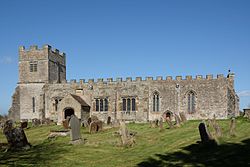Chesterton, Warwickshire
| Chesterton | |
| Warwickshire | |
|---|---|
 St Giles, Chesterton | |
| Location | |
| Grid reference: | SP348594 |
| Location: | 52°13’25"N, 1°28’54"W |
| Data | |
| Population: | 123 (2011) |
| Post town: | Leamington Spa |
| Postcode: | CV33 |
| Dialling code: | 01926 |
| Local Government | |
| Council: | Stratford-on-Avon |
| Parliamentary constituency: |
Kenilworth and Southam |
Chesterton is a small village in Warwickshire: the 2011 census recorded a population of 123. It is about five miles south of Leamington Spa, near the villages of Harbury and Lighthorne. The wider parish includes the agricultural area of Kingston east of the village.[1]
By the village stands the notable Chesterton Windmill, built in 1632 from a design attributed to Inigo Jones, just off the Fosse Way. It is Grade I listed building.
History


There was a Roman town here on the Fosse Way less than a mile from the present village of Chesterton[2] and this was mentioned in the Domesday Book of 1086.
The village changed names many times being Cestreyon (1043), Cestedone (1086), Cestertona (1170), Templer Cestreton (1185), Chastreton (1198), Casterton (1292) and Chesterton by 1350. Humble Bee cottages, on the hill where the manor ruins are, are now abandoned, but are thought to have been owned by the ancestors of Lord Willoughby de Broke (John Verney), who was descended from the owners of the manor. Originally, three terraced cottages existed, being rented by farm workers, but the cottage on the far right has been demolished.
The parish church dedicated to St. Giles, is thought to date back to the 12th century, the most recent update being in 1862. Parish records held at Warwick Records Office date back to 1538. At one time the church served the settlement of Chesterton. This settlement disappeared as a result of the inhabitants moving away to Chesterton Green, after receiving a visit from that most unwelcome of itinerants, the plague. Local rumour has it that tunnels connect the church to nearby Humble Bee cottages. In 1642 the Parish was merged with the neighbouring one of Kingston, to be renamed Chesterton and Kingston.[3]
Since the 1350s much of the village had been in the possession of the Peyto family who lived at Chesterton House. Chesterton House was demolished in 1802[4] after Margaret Peyto, last of the family, died in 1772 and left her estates to her cousin John Verney of nearby Compton Verney. The remains of the walls and gateway still stand. As well as being involved in the building of the windmill Sir Edward Peyto probably built the nearby watermill which started off as a court house but was converted to a mill in 1634. The stream supplying the mill pond created flooding problems so now no longer tops it up. In the 1960s an attempt to clear the pool failed, killing all the fish and making it stagnant. It was many years before the pool recovered and now has maximum dimensions of 315 by 105 metres.[5]

Outside links
| ("Wikimedia Commons" has material about Chesterton, Warwickshire) |
References
- ↑ A History of the County of Warwick - Volume 5 pp 42-46: Chesterton (Victoria County History)
- ↑ "Information for record number 798". Warwickshire County Council. http://timetrail.warwickshire.gov.uk/detail.aspx?monuid=WA798. Retrieved 23 October 2011.
- ↑ Noden, Dorothy A: The History of Chesterton and Kingston, page 66. Avon Litho Ltd, 1978
- ↑ The house's entry on the Our Warwickshire website
- ↑ Noden, Dorothy A: The History of Chesterton and Kingston, page 38. Avon Litho Ltd, 1978
